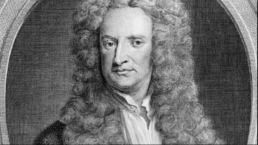These life stories may contain descriptions of childhood trauma and abuse, as well as images, voices and names of people now deceased. If you need help, you can find contact details for some relevant support services on our support page.
Noted scientist, Isaac Newton (1643-1727) was in kinship and foster care as a child. Isaac Newton was born into a Puritan family in Woolsthorpe, a small village in Lincolnshire, England.
His father, also Isaac Newton, was a farmer; he died a few months before Isaac was born. Newton’s mother remarried within two years. She and her new husband, the wealthy Reverend Barnabas Smith, relocated to another village, leaving Isaac to be raised by his grandmother. Isaac’s mother – who raised another three children with Smith – saw little to nothing of her eldest son for nine years, until the death of her second husband in 1653.
…his pronounced psychotic tendencies have been ascribed to this traumatic event…The acute sense of insecurity that rendered him obsessively anxious when his work was published and irrationally violent when he defended it accompanied Newton throughout his life and can plausibly be traced to his early years (Westfall, Britannica).
Isaac’s mother wanted her son to manage her property, but it soon became clear that he would not be an effective manager given his propensity to “curl up under a tree with a book” (Westfall, Britannica) rather than watch cattle or attend to other tasks.
Instead, Isaac Newton returned to the free grammar or university preparatory school in Grantham he had begun attending around the age of twelve. While at school he stayed with Joseph Clark, an apothecary.
He then went on to Trinity College, Cambridge, graduating in 1665 with a bachelor’s degree, at which time “the most remarkable undergraduate career in the history of university education had passed unrecognized” (Westfall, Britannica) because Newton’s understanding of the “new philosophy” and the “new mathematics” was confined to his notebooks.
Trinity College was closed for two years from 1665 because of the plague. Isolated at home, the young man began developing calculus, now the branch of mathematics considered the base line for going on to study physics, chemistry, economics, and biology.
Newton became a staff member at Trinity in 1667 and continued on at Trinity for twenty-eight years.
Early in his academic career, Newton delivered a series of lectures on optics and constructed “the first ever built” (Westfall, Britannica) reflecting telescope.
Newton went on to become of the most significant scientists in Western history, publishing what is considered his most important work, Philosophiae Naturalis Principia Mathematica, in 1687.
The crowning glory of Newton’s system was contained in his Principia Mathematica…in which he introduced the three laws of motion and the incredible notion of Universal Gravitation – the idea that all massive bodies continuously attracted all other bodies according to a mathematical law (Iliffe, 11).
Isaac Newton was knighted by Queen Anne in 1705. A statue of him by French sculptor Louis-Francois Roubiliac is located in the Ante-Chapel at Trinity College, a gift from Robert Smith in 1755.
By the time of his death in the spring of 1727, [Newton’s] reputation and achievements dwarfed those of any other natural philosopher who had lived. His standing has scarcely faded in the mean time, and in terms of the extent to which anyone’s scientific accomplishments surpass those of their contemporaries, Newton must be ranked above other heroes such as Darwin and Einstein (Iliffe, 104).
References:
Iliffe, Rob. Newton: a very short introduction. Oxford: Oxford University Press, 2007.
Smith, George. “Isaac Newton.” Stanford Encyclopedia of Philosophy, 2007. https://plato.stanford.edu/entries/newton/
Westfall, Richard. Isaac Newton. Oxford: Oxford University Press, 2007.
Westfall, Richard. “Isaac Newton. English physicist and mathematician.” Britannica. https://www.britannica.com/biography/Isaac-Newton
Image available here.
